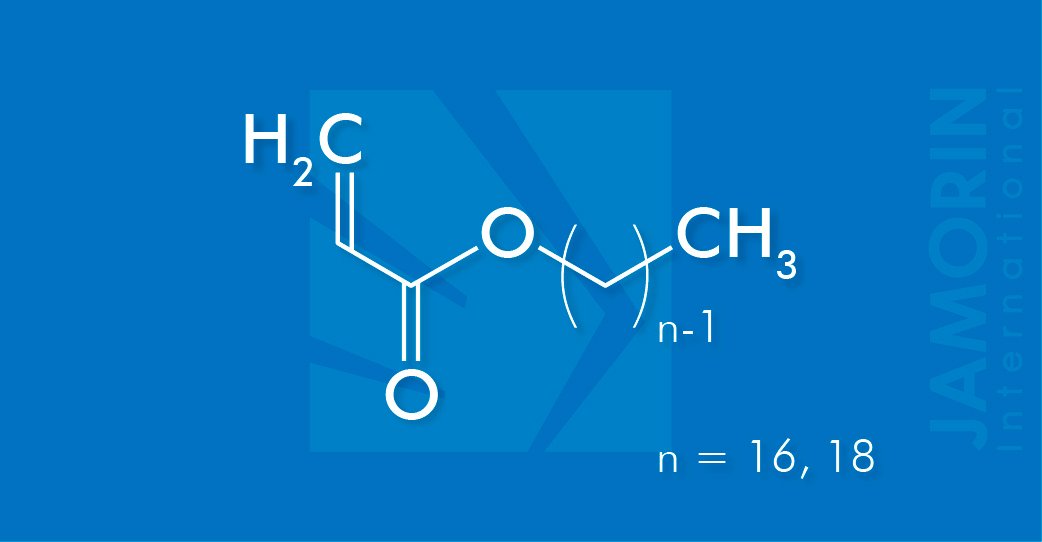C19H36O2
C21H40O2
min. 94 %
4813-57-4 (C18)
225-383-3 (C18)
C19H36O2
C21H40O2
min. 94 %
4813-57-4 (C18)
225-383-3 (C18)
Stearyl Acrylate 1618 (SA 1618)
Stearyl Acrylate 1618 (SA 1618) is an ester of Acrylic acid and is used as a raw material component in the synthesis of polymers. Stearyl Acrylate 1618 (SA 1618) is a monofunctional monomer with a characteristic high reactivity of acrylates and a long hydrophobic moiety. Copolymers of Stearyl Acrylate 1618 (SA 1618) can be prepared with (meth)acrylic acid and its salts, amides, and esters, and with methacrylates, acrylonitrile, maleic acid esters, vinyl acetate, vinyl chloride, vinylidene chloride, styrene, butadiene, unsaturated polyesters and drying oils, etc.
Stearyl Acrylate 1618 (SA 1618) is a very useful feedstock for chemical syntheses because it readily undergoes addition reactions with a wide variety of organic and inorganic compounds.
Features & Benefits:
- Hydrophobicity
- Adhesion
- Low Shrinkage
- Chemical resistance
- Impact resistance
- Flexibility
- Weatherability
Applications areas:
- Stearyl Acrylate 1618 (SA 1618) is used in pour-point depressants, slip-coatings, adhesives, oil additives, emulsifiers, and in release paper coatings.
It is applied in the production of:
- Automotive coatings
- Architectural coatings
- Industrial coatings
- Adhesives
- Plastics
- UV Curable compositions
- Personal Care
- Emulsifiers
- Motor oil additives
- Oilfield chemicals
Chemical Properties:
-
Puritymin. 94 %
-
Acid Valuemax. 0.05 %
-
Water contentmax. 0.1 %
-
Color APHAmax. 150
Physical Properties:
-
Appearanceclear, pale yellow
-
Physical formsolid or liquid
-
Molecular weight296.5 g/mol (C16) / 324.6 g/mol (C18)
-
Boiling Point160 °C at 3 hPa
-
Flash point190 °C
-
Melting Point20 °C
In order to prevent polymerization, Stearyl Acrylate 1618 (SA 1618) must always be stored under air, and never under inert gases. The presence of oxygen is required for the stabilizer to function effectively. It has to contain a stabilizer and the storage temperature must not exceed 35 °C. Under these conditions, a storage stability of one year can be expected upon delivery. In order to minimize the likelihood of overstorage, the storage procedure should strictly follow the “first-in-first-out” principle.If Stearyl Acrylate 1618 (SA 1618) is crystallized the product can be melted safely with heating temperatures up to 60 °C. It should not be stored at this temperature for more than 5 days in order to prevent degradation in quality and premature formation of polymer fractions. In order to reduce the thermal stress during the melting process air convection should be very good. Under such favorable conditions melting can be achieved within 24 hours.The preferred construction material for tanks and pipes is stainless steel. Carbon steel is also acceptable, although the formation of rust may be a problem with product quality (color). Iron(III)-ions have been shown to be a weak polymerization initiator. If carbon steel is to be used, special procedures should be used to prepare the tank for use. Storage tanks, pumps and pipes should be earthed.
Storage & Handling:
In order to prevent polymerization, Stearyl Acrylate 1618 (SA 1618) must always be stored under air, and never under inert gases. The presence of oxygen is required for the stabilizer to function effectively. It has to contain a stabilizer and the storage temperature must not exceed 35 °C. Under these conditions, a storage stability of one year can be expected upon delivery. In order to minimize the likelihood of overstorage, the storage procedure should strictly follow the “first-in-first-out” principle.If Stearyl Acrylate 1618 (SA 1618) is crystallized the product can be melted safely with heating temperatures up to 60 °C. It should not be stored at this temperature for more than 5 days in order to prevent degradation in quality and premature formation of polymer fractions. In order to reduce the thermal stress during the melting process air convection should be very good. Under such favorable conditions melting can be achieved within 24 hours.The preferred construction material for tanks and pipes is stainless steel. Carbon steel is also acceptable, although the formation of rust may be a problem with product quality (color). Iron(III)-ions have been shown to be a weak polymerization initiator. If carbon steel is to be used, special procedures should be used to prepare the tank for use. Storage tanks, pumps and pipes should be earthed.
A Safety Data Sheet has been compiled for Stearyl Acrylate 1618 (SA 1618) that contains up-to-date information on questions relevant to safety.
The data contained in this publication are based on our current knowledge and experience. In view of the many factors that may affect the processing and application of our product, these data do not relieve processors from carrying out their own investigations and tests; neither do these data imply any guarantee of certain properties, nor the suitability of the product for a specific purpose. Any descriptions, drawings, photographs, data,
proportions, weights, etc. given herein may change without prior information and do not constitute the agreed contractual quality of the product. It is the responsibility of the recipient of our products to ensure that any proprietary rights and existing laws and legislation are observed.
